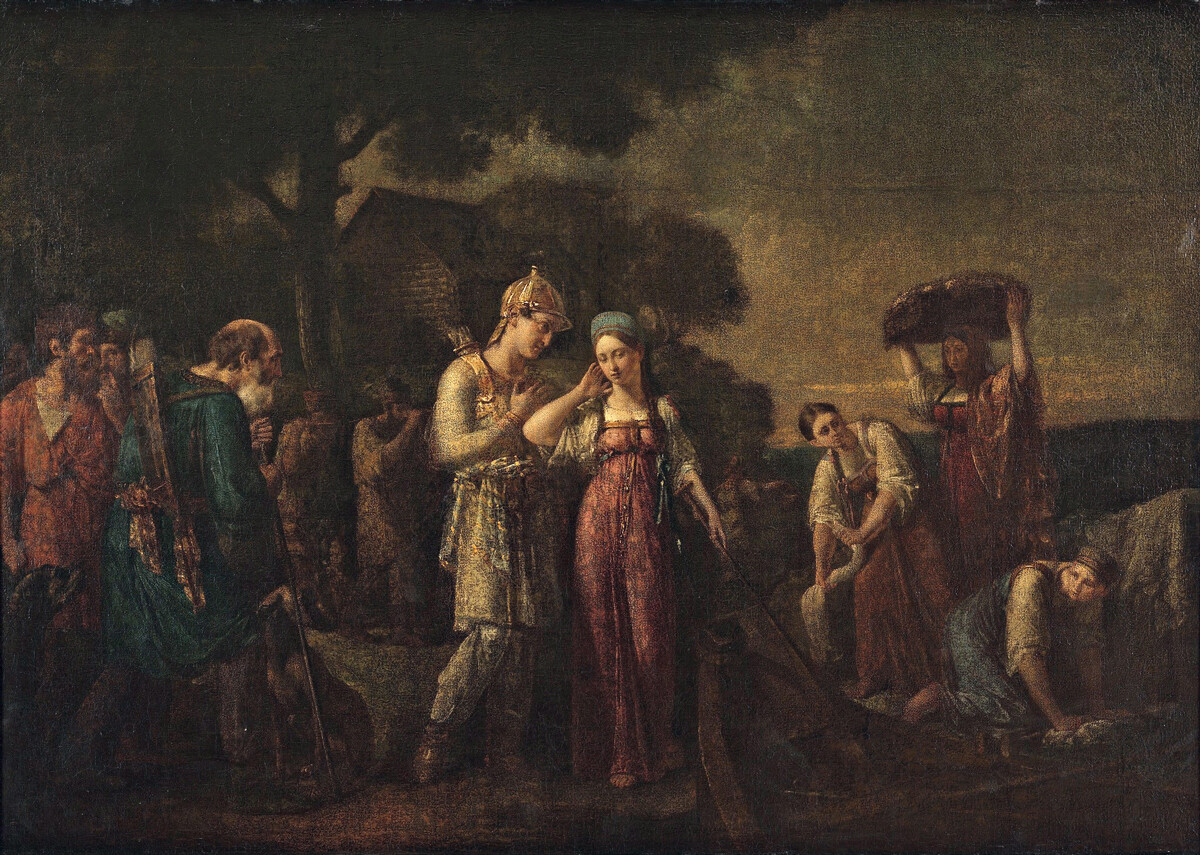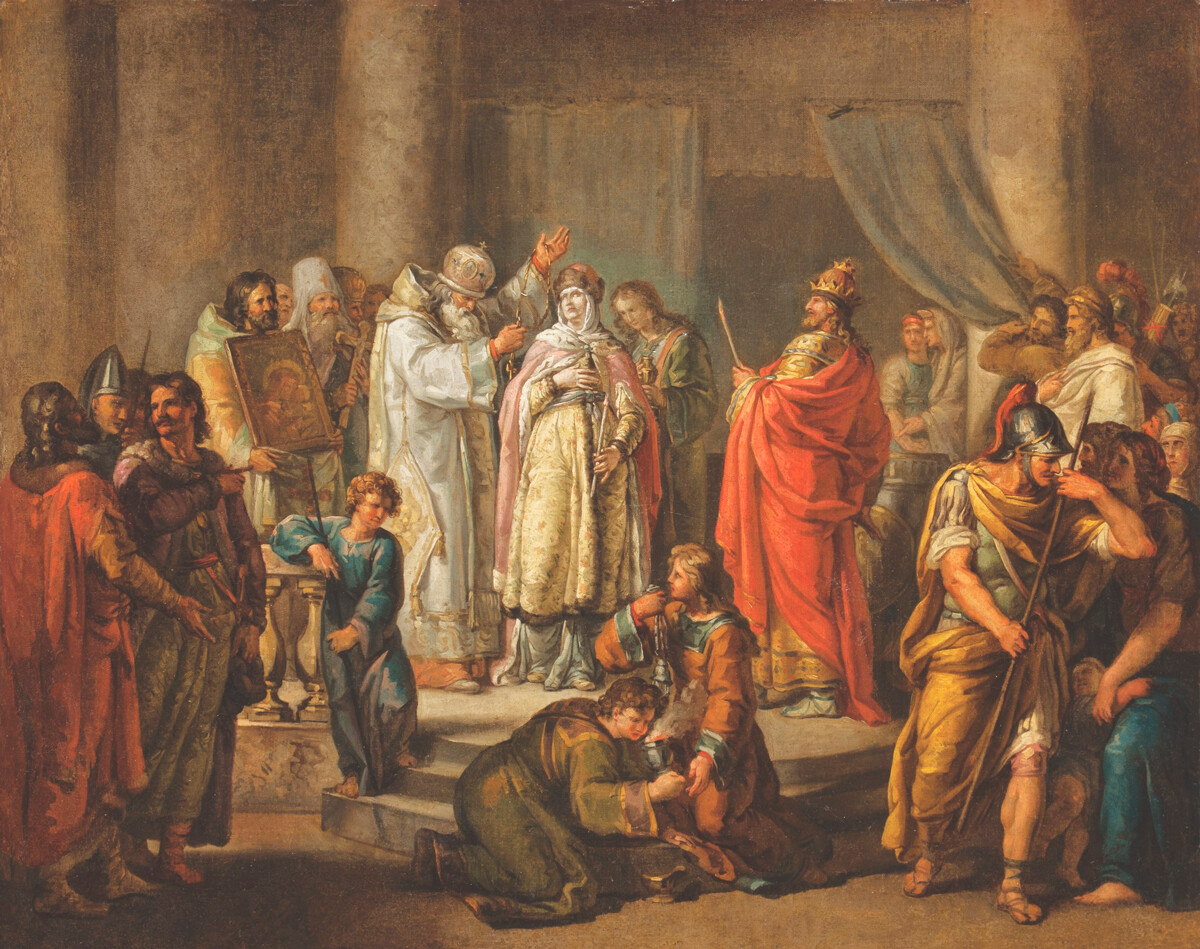Why Russians venerate Saint Olga who burned down whole cities

The first woman recognized to be a saint in Rus’ was initially a pagan, shooting to fame following her brutal revenge for her husband’s death. Yet, later, she brought Christianity to the Russian lands and raised her grandson Prince Vladimir, who, consequently, baptized the whole country.
 Saint Olga, Princess of Kiev.
Saint Olga, Princess of Kiev.
Princess Olga’s four severe acts of revenge
Olga appeared on the historical scene after the death of her husband, Prince Igor of Kiev, in 945, according to the Russian chronicle ‘The tale of bygone years’ (the Rus’ Primary Chronicle). He was brutally murdered when he was collecting tax from the Drevlian tribes, who were subordinate to Kiev. He was tied up to two bent aspens and, as they straightened up, he was torn into two halves.
Having done away with the Kiev prince, the Drevlians decided they could also lay their hands on his throne. To do it, they intended to marry their prince Mal to Igor’s young widow and sent matchmakers to her.
- Despite her young age, Princess Olga apparently saw the danger posed to her and all Kievan Rus’. When a boat with 20 Drevlian messengers reached Kiev, she decided not to reject them; quite the opposite, she ordered her servants to lift the boat and carry it in their arms to Kiev as a sign of honor and respect for the Drevlians. When they arrived in the city, the messengers were thrown into a deep, specially dug pit.
- As there was nobody to tell the Drevlians about their envoys’ fate, they believed Kiev’s messenger, who said that Olga would be happy to get married again, but wanted the Drevlians to send their more noble people as matchmakers to her. This time, the best representatives of the Drevlian tribes, merchants and boyars, headed to Kiev. Olga told them to wash up after their journey before she could see and talk to them. When the messengers went to do it, they got locked in the sauna (Russian banya), which was shortly burnt down.
- After that, having taken just a small number of guards with her, Olga told the Drevlians that, in line with a Slavic tradition, she would prefer to have a funeral feast (trizna) at the place of her husband’s death on the Drevlian soil. The tribal people wondered where their previously sent matchmakers were, with Olga putting their mind at rest, saying they were traveling together with her guards. Having reached Igor’s tomb, she threw a big commemorative feast, where the Drevlians drank and Olga’s guards served them. As soon as the former got drunk, Olga’s people killed them.
- It was not the end, though. In 946, Olga and her large army went ahead and attacked the Drevlians, besieging their major city of Iskorosten. The Drevlians stood up against them, with Kievans unable to defeat them for as long as a year. Olga then sent messengers into the city, suggesting ending the siege and reaching peace conditioned that the Drevlians agreed to give her a bit of a tribute: three pigeons and three sparrows from every household. The unsuspecting enemy met her condition, but, when darkness fell, Olga ordered to tie a stick made of inflammable material to every bird, light it and release the birds. They all flew to their roofs, which were covered with hay at the time, and the whole city was instantly set on fire. The panic-stricken Drevlians fled the city, with the Kievan army meeting them right outside. After the city fell, Olga imposed a tax on the local tribes to be paid into Kiev’s treasury.
 Olga`s first revenge on Drevlians by Fyodor Bruni, 1839.
Olga`s first revenge on Drevlians by Fyodor Bruni, 1839.
Olga’s wisdom
Despite such a sophisticated revenge, Olga was by far not a freaky whip-cracker. Such a crackdown on the Drevlians in those violent pagan times served as a visual demonstration that there was no way one could seize the Kievan throne that had lost its ruling prince. Besides, such actions also granted her support within the country: both her guards and the local nobility woke up to the fact that she was a decisive and politically mature ruler.
Olga also visited the lands under Kiev’s rule and set up so-called ‘pogosti i uroki’ there, namely the exact amount of tax due to be paid and the administrative centers where it was supposed to be collected. She understood that her husband had died, to a great extent, due to the fact that the amount of tax and the rules on how it should be collected had never been determined. From Olga’s time onward, the ruler’s representatives were not only in charge of collecting tax, but they also monitored it, resolved court cases, while the prince didn’t have to collect tax himself. In fact, Olga managed to set up the first administrative structure, which enabled the ruler to get tax and relevant information through their subordinates without having to leave the capital.
Thus, as early as in her youth, Olga earned the nickname of “the wisest of all”. This characteristic is also supported in a legend telling about her origin and the way she met Prince Igor. While hunting near Pskov, Igor asked a ferryman to take him across the river, but, already in a boat, he saw that it was a young, beautiful girl. According to the customs of those times, he was certain that a commoner would hardly be against the prince’s attention, but the girl decisively pushed back, promising, according to one legend, to drown herself in the river or throw the prince there, as another one has it. The prince was so impressed by her beauty, character and common sense, that as soon as he decided to get married, he ordered to find that very Olga.
 The first meeting of prince Igor with Olga by Vasily Sazonov, 1824.
The first meeting of prince Igor with Olga by Vasily Sazonov, 1824.
Christening in Constantinople
Olga’s wisdom also consisted in the fact that she was no longer satisfied with her people’s pagan beliefs. She increasingly took note of Christians, whose number was on the rise in Kiev. Historians don’t have a unified approach as to what made Olga take action - her personal affinity for Christianity or political interests and understanding that a more “advanced” faith was needed for the country’s development. Whatever the case, Olga made up her mind to adopt Christianity and, with this in mind, she set out for the Byzantine capital Constantinople.
A wealth of legends center on Olga’s trip, much like on her entire rule. One of them has it, that Emperor Constantine Bagryanorodny, who later became Olga’s godfather, attempted to propose to her, but Olga masterly evaded this marriage.
After she came back to Kiev, she became the first Christian in Rus’ (at least of noble descent). Her example had no effect on her son Svyatoslav, who stayed pagan until his very death. However, Olga’s grandson Vladimir, who had been brought up by the princess, according to a legend, was not only baptized himself, but christened the entire Rus’. Also, after Olga’s return, Kiev saw Christian churches being built (Olga is believed to be a pioneer of stone construction in Rus’), services being held, with their own priests appearing in the city. Christianity was no longer seen by the residents as something weird or alien, with people increasingly getting baptized.
 The Baptism of Olga by Ivan Akimov, 1792.
The Baptism of Olga by Ivan Akimov, 1792.
Equal to the Apostles
Olga died in the year 969 and started to be revered as a saint between 972 and 978. She was canonized as the first Christian in Rus’ and “the wisest of all people”. Her pagan revenge on the Drevlians didn’t count, as it had happened in her “previous” life - prior to her baptism. Her biography states: “Princess Olga ruled the Russian lands she was in charge of not like a woman, but like a strong and sensible man.” The reverence for Olga was so deep, that in 1547, she was recognized not merely as a saint, but equal-to-the-Apostles. There are only five such women around the world, including Mary Magdalene, among others.

